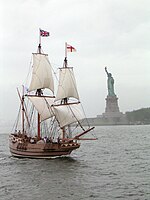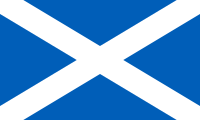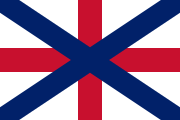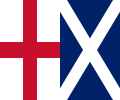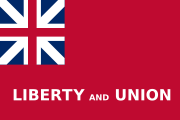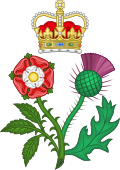Flag of Great Britain
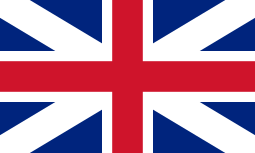 | |
| King's Colours | |
| Use | Civil and state flag |
|---|---|
| Proportion | 3:5 |
| Adopted | 1707 (origin 1606) |
| Relinquished | 1801 |
| Design | Four stripes of white, horizontal, diagonal, and vertical on a blue field, with a red cross in the middle. |
| Red Ensign of Great Britain | |
 | |
| Use | Civil and naval ensign |
| Design | A red field with the flag of Great Britain in the canton |
| Blue Ensign of Great Britain | |
 | |
| Use | Civil and naval ensign |
| Design | A blue field with the flag of Great Britain in the canton |
| White Ensign of Great Britain | |
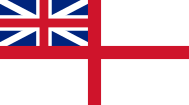 | |
| Use | Naval ensign |
| Design | A cross of St George with the flag of Great Britain in the canton |
The flag of Great Britain, commonly known as King's Colours, the first Union Flag,[1][2] the Union Jack, or the British flag, was used at sea from 1606 and more generally from 1707 to 1801. It was the first flag of the Kingdom of Great Britain.[3][4] It is the precursor to the Union Jack of 1801.
The design was ordered by King
The flag consists of the
The flag's official use came to an end in 1801 with the creation of the
Creation
By
By the King: Whereas, some differences hath arisen between Our subjects of South and
St. George's Crosse, and the White Crosse, commonly called St. Andrew's Crosse, joyned together according to the forme made by our heralds, and sent by Us to our Admerall to be published to our Subjects: and in their fore-toppe our Subjects of South Britaine shall weare the Red Crosse onely as they were wont, and our Subjects of North Britaine in their fore-toppe the White Crosse onely as they were accustomed.
-
A replica of the early 17th century Godspeed flying the flags of Great Britain and the Kingdom of England
-
The flag of England
-
The flag of Scotland
At the funeral of King James in 1625 the flag was called the "Banner of the Union of the two Crosses of England and Scotland".[6] James had the habit of referring to a "Kingdom of Great Britain", considering that it had been created by the Union of the Crowns. However, despite the personal union which he represented, in practice England and Scotland continued as separate kingdoms, each with its own parliament and laws, for another century. The Kingdom of Great Britain finally came into being in 1707.[7] The flag of the new Kingdom was formally chosen on 17 April 1707, two weeks before the Acts of Union of 1707 were to take effect. Henry St George, Garter Principal King of Arms, had presented several possible designs to Queen Anne and the Privy Council.[8]
Scottish variant
The principal alternative for consideration was a version of the flag with the saltire of Saint Andrew lying on top of that of Saint George, called the "Scots union flag as said to be used by the Scots", but this was rejected.[citation needed]
-
Another early proposal for the Union Jack, consisting of a white St Andrew's saltire with blue fimbriation superimposed over a red St George's cross on a field of white.

-
A reconstruction of an alternative version of the Union Jack that appears on a painted wooden ceiling boss from Linlithgow Palace (c. 1617).

Proposed versions
In the wake of the personal union between England and Scotland, several designs for a new flag were drawn up, juxtaposing the St George's Cross and the St Andrew's Saltire:[9]
However, none were acceptable to James.[9]
After 1801
With the 1801 change to the British flag,
-
Commissioners' flag of the Northern Lighthouse Board
-
Weymouth, New Jersey
-
Flag of Baton Rouge, Louisiana
-
Flag of Mobile, Alabama
-
Flag of Somerset County, Maryland The flag was adopted in 1694, based on the King's Colours from 1606.
See also
- List of English flags
- List of Scottish flags
- Protectorate Jack
- Union Flag
- List of flags of the United Kingdom
References
- ^ Ciara.Berry (2016-01-15). "Union Jack". The Royal Family. Archived from the original on 2022-05-26. Retrieved 2022-06-26.
- ^ "Part 1: The Australian National Flag". Department of the Prime Minister and Cabinet. Archived from the original on 2022-06-26. Retrieved 2022-06-26.
- ^ "British Flags". Flaginstitute.org. Archived from the original on 2015-08-17. Retrieved 2014-10-27.
- ^ "The Union Jack or The Union Flag?". Flaginstitute.org. Archived from the original on 2013-06-13. Retrieved 2014-10-27.
- ^ "History of the Union Flag | UK Flags". The Flag Institute. Archived from the original on 2023-01-07. Retrieved 2023-01-07.
- ^ John Nichols, Progresses of James the First, vol. 4 (London, 1828), pp. 1043-4.
- ^ Michael Lynch, The Oxford Companion to Scottish History (2001), p. 356
- ^ Linda Colley, Taking Stock of Taking Liberties: A Personal View (British Library, 2009), p. 46
- ^ a b c Duffy, Jonathan (10 April 2006). "Union recognition". BBC. Archived from the original on 30 November 2020.
· Graphic (archive of Graphic) - ^
- Prothero, David (28 March 2006). "United Kingdom: lighthouse authorities". Flags of the World. Commissioners of Northern Lighthouses - Commissioner's flag. Archived from the original on 6 January 2022. Retrieved 6 January 2022.
- citing
Brownlie, Bob (Christmas 2001). "Flags and Pennants". Journal of the Northern Lighthouse Board. OCLC 1181103575.
- ^ "Sierra Leone". Flags, badges & arms of His Majesty's dominions beyond the seas and of territories under His Majesty's protection. Vol. 2: Arms. London: HMSO. 1932. p. 31. Archived from the original on 2022-01-06. Retrieved 2022-01-06.
- OCLC 1011001515. Archived(PDF) from the original on August 19, 2019. Retrieved February 3, 2020.
- ^ "Somerset County Flag" (PDF). visitsomerset.com. Princess Anne, Maryland: Somerset County Tourism. Archived from the original (PDF) on 8 September 2015.
- ^ "Taunton, Massachusetts (U.S.)". Flags of the World. Archived from the original on 2 December 2021. Retrieved 7 January 2022.
- ^
- "Rattlesnake Flag". Borough of New Alexandria. Archived from the original on 7 January 2022. Retrieved 7 January 2022.
- "Rattlesnake Flag". Westmoreland County Historical Society. Archived from the original on 7 January 2022. Retrieved 7 January 2022.

